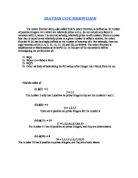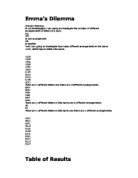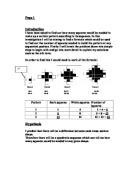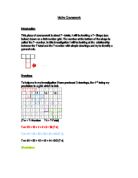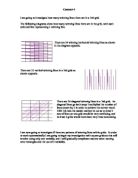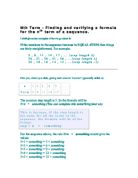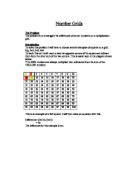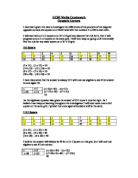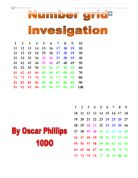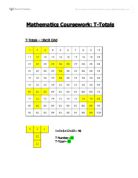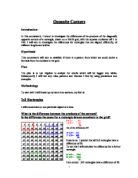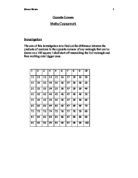The totient function.
Maths Coursework The totient function ?(n), also called Euler's totient function, is defined as the number of positive integers <= n which are relatively prime to (i.e., do not contain any factor in common with) n, where 1 is counted as being relatively prime to all numbers. Since a number less than or equal to and relatively prime to a given number is called a totative, the totient function ? (n) can be simply defined as the number of totatives of n. For example, there are eight totatives of 24 (1, 5, 7, 11, 13, 17, 19, and 23), so ?24=8. The totient function is implemented in Mathematics as EulerPhi [n]. In this part of the coursework will be investigating the phi function of: ) ?(p) 2) ?(m x n) = ?(m) x ?(n) 3) ?(pn) 4) Other methods of calculating the Phi values of an integer that I found from the net. Find the value of: (i) ?(3): = 2 3 = 1,2 The number 3 only has 2 positive co-prime integers they are the numbers 1 and 2. (ii) ?(8): = 4 8 = 1,3,5,7 There are 4 positive co-prime integers for the number 8 (iii) ?(11): = 10 1 = 1,2,3,4,5,6,7,8,9,10 The number 11 has 10 positive co-prime integers, and they are shown above. (iv) ?(24): = 8 24 = 1,5,7,11,13,17,19,23 The number 24 has 8 positive co-prime integers, and they are shown above. Part 1 In this part I will try to investigate on ?(n). But before we can start we need to experiment on certain numbers.
Opposite Corners
Louis Franks 10PC 10X2 10/12/01 Opposite Corners Wx L Difference Increase Wx L Difference Increase 2 x 3 20 0 6 x 3 00 50 2 x 4 30 0 6 x 4 50 50 2 x 5 40 0 6 x 5 200 50 2 x 6 50 0 6 x 6 250 50 2 x 7 60 0 6 x 7 300 50 2 x 8 70 0 6 x 8 350 50 2 x 9 80 0 6 x 9 400 50 2 x 10 90 0 6 x 10 450 50 We are investigating the difference between the products of the numbers in the opposite corners of any rectangles that can be put on a 100 square. 2 x 3 Rectangles 2 3 1 2 3 To keep things simple I have started with rectangles with a width of 2 squares. I kept the width to two squares and increased the length by one square. (see results table above). I discovered that the width increases by 10 every time the length increases by 1. The difference can be worked out for all rectangles with a width of 2 squares by using several formulas: . (Length - 1 x 10 = Z) 3 - 1x 10 = 20 = Z Then (Width x Z ) - Z = difference of opposite corners 2 x 20 - 20 = 20 OR 2. L = Length, W = Width (L - 1) (10 (W-1)) = difference of opposite corners Example: (3 - 1) x (10 (2 - 1)) = 20 OR 3. 2 3 1 2 3 Using algebra and going on the theory that the width increases by 10 when the length is increased by 1, I have
Emma's Dilemma.
Emma's Dilemma Emma's Dilemma In my investigation I am going to investigate the number of different arrangements of letters in a word. e.g. Tim Is one arrangement Mit Is another First I am going to investigate how many different arrangements in the name LUCY, which has no letters the same. LUCY LUYC LYCU LYUC LCYU LCUY ULCY UCLY UYLC ULYC UCYL There are 4 different letters and there are 24different arrangements. SAM SMA MSA MAS ASM AMS There are 3 different letters in this name and 6 different arrangements. JO OJ There are 2 different letters in this name and there are 2 different arrangements. UYCL YCUL YUCL YULC YLCU YLUC CYLU CYUL CUYL CULY CLUY Table of Results Number of Letters Number of Different Arrangements 2 2 3 6 4 24 5 20 6 720 7 5040 From the table of results I have found out that a 2 letter word has 2 arrangements, and a 3 letter word has 6. Taking for example a 3 letter word, I have worked out that if we do 3 (the length of the word) x 2 = 6, the number of different arrangements. In a 4 letter word, to work out the amount of different arrangements you can do 4 x 3 x 2 = 24, or you can do 4!, which is called 4 factorial which is the same as 4 x 3 x 2. So, by using factorial (!) I can predict that there will be 40320 different arrangements for an 8 letter word. The formula for this is: n! = a Where n =
The Relationship between the T-Number and the T-Total
The Relationship between the T-Number and the T-Total The T-Total is the number that is derived from the sum of all numbers within a 'T' shape placed on a numbered grid. The T-Number is the number at the bottom of the 'T' : I have been asked to find the relationship between the T-number and The T-Total and devise a formula to derive the T-Total from any given T-Number of any translation of the 'T' shape. The grid below is 9*9 meaning that any number on the grid is nine less than the one below. This means that the number above the T-Number will always be 9 less than it, it also means that the number two squares above the T-Number is 18 less and the two either side are 17 less and 19 less than the T-Number. This means that: T-Number = TN T-Total = TN + TN - 9 + TN -18 + TN - 17 + TN -19 So T-Total = 5TN - 63 So to test the formula: Eg. 1 2 3 4 5 6 7 8 9 0 1 2 3 4 5 6 7 8 9 20 21 22 23 24 25 26 27 28 29 30 31 32 33 34 35 36 37 38 39 40 41 42 43 44 45 46 47 48 49 50 51 52 53 54 55 56 57 58 59 60 61 62 63 64 65 66 67 68 69 70 71 72 73 74 75 76 77 78 79 80 81 + 2 + 3 + 11 + 20 = 37 And: 5*20 = 100 - 63 = 37 Eg. 2 2 3 4 5 6 7 8 9 0 1 2 3 4 5 6 7 8 9 20 21 22 23 24 25 26 27 28 29 30 31 32 33 34 35 36 37 38 39 40 41 42 43 44 45 46 47 48 49
have been asked to find out how many squares would be needed to make up a certain pattern according to its sequence
Page 1 Introduction I have been asked to find out how many squares would be needed to make up a certain pattern according to its sequence. In this investigation I will be aiming to find a formula which could be used to find out the number of squares needed to build the pattern at any sequential position. Firstly I will break the problem down into simple steps to begin with and go into more detail to explain my solutions such as the nth term. In order to find this I would need to work of the formula: Term 1 Term 2 Term 3 Term 4 B=1 B=5 B=13 B=25 W=4 W=8 W=12 W=16 Pattern Dark squares White squares Number of squares 4 + 4 = 5 2 5 8 5 + 8 = 13 3 3 2 3 + 12 = 25 Hypothesis I predict that there will be a difference between each cross-section shape. Therefore there will be a quadratic sequence which can tell me how many squares would be needed in any given shape. Page2 Prediction + 3 + 1 = 5 + 3 + 5 +3 + 1 = 13 + 3 + 5 + 7 + 5 + 3 + 1 = 25 + 3 + 5 + 7 + 9 + 7 + 5 + 3 + 1 = 41 If you notice in my prediction there is a pattern of
In this investigation I will be looking at the relationship between the T-total and the T-number with simple drawings and try to identify a general rule.
Maths Coursework Introduction This piece of coursework is about T- totals. I will be looking a T- Shape (see below) drawn on a 9x9 number grid. The number at the bottom of the shape is called the T- number. In this investigation I will be looking at the relationship between the T-total and the T-number with simple drawings and try to identify a general rule. Drawings To help me in my investigation I have produced 3 drawings, the 4th being my prediction in a grid which is 9x9. (T-n = T- Number T-t = T-Total) T-n= 21 + 12 + 1 + 2 +3 = 39 (T-t) T-n= 41 + 32 + 22 + 23 + 24 =142 (T-t) T-n= 61 + 52 + 42 + 43 + 44 =242 (T-t) (Prediction) T-n= 81 + 72 + 62 + 63 + 64 = 337 (T-t) Table of Results With the T-shapes drawn in the grid above I can now put my results in a table to see if there are any patterns occurring. Identifying the pattern As you can see from my table of results that the T-total is increasing by 100 every time you add 20 to the T-number. Prediction I predict that the next T-total will be 337 and the T-number will =80. My prediction is already included on the 9x9 grid it is the Green T-shape. Testing my prediction My prediction was correct as you can see on the grid the green T-shape =337. T-n= 81 + 72 + 62 + 63 + 64 = 337 (T-t) General Rule The general
investigate how many winning lines there are in a 7x9 grid.
I am going to investigate how many winning lines there are in a 7x9 grid. The following diagrams show how many winning lines there are in the grid, with each coloured line representing 1 winning line. There are 24 winning horizontal winning lines as shown in the diagram opposite. There are 21 vertical winning lines in a 7x6 grid as shown opposite. There are 24 diagonal winning lines in a 7x6 grid. As diagonal lines go both ways I multiplied the number of lines shown by 2 in order to achieve the correct result. I felt this was the easiest method to use as to draw 2 sets of lines on one grid would be very confusing, and to draw 2 grids would have been very time consuming. I am now going to investigate if there are patterns of winning lines within grids. In order to work systematically I am going to begin my investigation with square grids as this will involve using only one variable, and I will gradually complicate matters when moving onto rectangles and the use of 2 variables. Square Grids I am now going to investigate winning lines in square grids. I am going to put my results in a table to enable me to spot any patterns that occur. Winning Lines n (grid size) Horizontal Vertical Diagonal 4 4 4 2 5 0 0 8 6 8 8 8 As we can see horizontal and vertical winning lines are the same in square grids. Horizontal and Vertical Rules The first difference is
Nth Term - Finding and verifying a formula for the nth term of a sequence.
Nth Term - Finding and verifying a formula for the nth term of a sequence. I shall give some examples of how to go about it. If the numbers in the sequence increase in EQUAL STEPS then things are fairly straightforward. For example: 5 , 8 , 11 , 14 , 17 , ... (step length 3) 26 , 31 , 36 , 41 , 46 , ...(step length 5) 20 , 18 , 16 , 14 , 12 , ...(step length -2) First you, draw up a table, giving each term its "counter" (generally called n) n 2 3 4 5 . . . Term 5 8 1 4 7 . . . The common step length is 3. So the formula will be 3×n + something (You can complete this something later on) This is because, if the step length is the same for all the terms in the sequence, the formula will be of the format: step × n + something For the sequence above, the rule 3×n + something would give the values 3×1 + something = 3 + something 3×2 + something = 6 + something 3×3 + something = 9 + something 3×4 + something = 12 + something 3×5 + something = 15 + something You then compare these values with the ones in the actual sequence - it should be obvious that the value of the something is +2 So the formula for the nth term is 3n + 2 That's Easy Enough! A second example.... n 2 3 4 5 . . . Term 26 31 36 41 46 . . . The common step length is 5. So the formula will be 5×n +
T-Totals Maths
T-Totals Coursework My aim is to investigate the relationship between the T-Number and the T-shape on a varying size of grid. 2 3 4 5 To the left is a basic T-shape. In this investigation, the number in bold which is "5" is the T-Number. The sum of the all the numbers in the T-shape is the T-Total. For Example: 1+2+3+4+5 = 10. Therefore the T-Total for this T-Shape is 10. Using this information I can now begin my investgation. 2 3 4 5 6 7 8 9 0 1 2 3 4 5 6 7 8 9 20 21 22 23 24 25 26 27 28 29 30 31 32 33 34 35 36 37 38 39 40 41 42 43 44 45 46 47 48 49 50 51 52 53 54 55 56 57 58 59 60 61 62 63 64 65 66 67 68 69 70 71 72 73 74 75 76 77 78 79 80 81 I am going to start my investiation on a 9 by 9 grid. This shows all the numbers from 1 to 81. Firstly in my investigation, I am going to find a formula that relates my T-Number to my T-Total, firstly with a 9x9 grid and then onto a grid of any size. To work out my formula I have drawn two T-Shapes on my grid. The first t-shape in green has a T-Number of 20. The other T-Shape highlighted in pink has been translated one number to the right giving it a T-Number of 21. I then worked out the T-Total for both shapes. Green T-Shape: 1+2+3+11+20 = 37 Pink T-Shape: 2+3+4+12+21 = 42 T-Number T-Total 20 37 +5 21 42
Number Grids
Number Grids The Problem The problem is to investigate the differences of corner numbers on a multiplication grid. Introduction To solve this problem I will have to choose several examples of squares on a grid: E.g. 2x2, 3x3, 4x4 To work this out I will need to take the opposite corners of the square and subtract them from the other sum of the two corners. This is easier seen in the diagram shown below: *The RED numbers are always multiplied then subtracted from the sum of the YELLOW numbers. 2 3 4 5 6 7 8 9 0 1 2 3 4 5 6 7 8 9 20 21 22 23 24 25 26 27 28 29 30 31 32 33 34 35 36 37 38 39 40 41 42 43 44 45 46 47 48 49 50 51 52 53 54 55 56 57 58 59 60 61 62 63 64 65 66 67 68 69 70 71 72 73 74 75 76 77 78 79 80 81 82 83 84 85 86 87 88 89 90 91 92 93 94 95 96 97 98 99 00 This is an example of a 2x2 square. I will then make an equation with this: Difference= (2x11)-(1x12) = 10 The difference for this example is ten. 2x2 Squares I will use on grid to use several example of 2x2 squares by placing them randomly on the grid. 2 3 4 5 6 7 8 9 0 1 2 3 4 5 6 7 8 9 20 21 22 23 24 25 26 27 28 29 30 31 32 33 34 35 36 37 38 39 40 41 42 43 44 45 46 47 48 49 50 51 52 53 54 55 56 57 58 59 60 61 62 63 64 65 66 67 68 69


